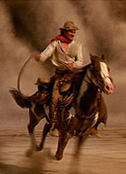
Movie Guru Rating:

Comment
on this review
| |

Hidalgo is not your grandfather’s Western
by Jack Neely
Hidalgo is the story of a cowboy and his horse. It’s an unusual horse, a two-toned mustang that anticipates its owner’s wishes, in the tradition of Roy Rogers’ remarkable steed, Trigger.
The movie begins and ends in the historical Wild West. It could easily have been a cowboys-and-Indians flick of a different era, except that it’s 2004, and the Indians are our friends. The handiest villains for cowboys to fight now are, of course, the Islamic Arabs, and the best place to fight them is in Iraq. It would seem a far-fetched, exploitive idea—this archetypal American cowboy finding himself in Iraq with his Colt six-shooter banging away at berobed Muslims—except that Hidalgo is allegedly based on the true story of Frank T. Hopkins.
Mr. Hopkins is portrayed in the movie as a mixed-race Dakotan who speaks fluent Lakota. Known as an endurance rider with a passion for mustangs, he barely misses the massacre at Wounded Knee, which he abhorred; he’s such a heroic figure you get the impression that it happened only because he stepped away for a moment. The drinking Hopkins seems to have fallen on hard times, reduced to appearing in Buffalo Bill’s bizarre Wild West Show. Only then, 20 minutes into the movie, do we discover this isn’t your grandfather’s Western.
Our first clue is when one disreputable-looking foreigner attending the show leans toward another and says, “What think you of the show, Aziz?”
The result of that contact is Hopkins’ entry into what must be the most strenuous horserace in the world, a 3,000-mile race from Aden through the sand to Damascus. Most of the movie is about that race—with quicksand, traps, sandstorms, one plague of locusts, and lots of villainous trickery. The unexpected alliances make it sort of Survivor: Arabia with daggers instead of blackballs.
The movie has only a passing acquaintance with history. The fact that the characters repeatedly refer ominously to “Iraq,” which didn’t exist as a country until about 30 years later, may be the least of this movie’s historically questionable points. Another is that the 3,000-mile, 68-day race ends in a photo finish. (In the real race, of which very little is known, the second finisher followed the first by 33 hours.)
And most troubling for screenwriters is that in the real Hopkins’ own laconic accounts of the race, he mentions having no cross words with his Arab competitors—much less gun, knife, and spear fights to the death. All he allowed about the race was that it got dusty at times. Obviously, the real race wouldn’t have made for much of a blockbuster, and for Americans to accept a movie based in the Arab world, you have to throw in a few evildoers. Several of these characters appeared in other movies of half a century ago, but previously they wore war paint. A couple of them I think I also recognize from Disney’s previous effort, Aladdin.
The Hopkins character, played by Viggo Mortenson (Aragorn, in the Lord of the Rings series), is so utterly matchless at everything he assails, compared to his rascally competitors, that you get the impression that the screenwriters engaged in some complicated algebra to carefully balance good and evil and race to avoid the taint of Nordic supremicism. So some of the worst characters are British, some of the best are Lakota, and even some of the Arabs turn out to be regular fellows. Fans of Dr. Zhivago will be relieved to know that Omar Sharif is one of them. (For some, hearing Sharif say, “There is a tempest in my tent” in Arabic will be worth the price of admission.) Another is his lovely daughter, played by Zuleika Robinson, who’s the closest thing to a romantic interest in the movie. (When she drops her veil, she’s wearing makeup, and could pass for a tempting salesgirl at Macy’s.)
In the end, the presumed “will of Allah” is defeated, but in the spirit of the non-racist equation, the victor is not the Judeo-Christian Jehovah, but the Lakota Great Spirit.
The historical Hopkins was actually best known for his efforts on behalf of the wild mustang, a nod to that fact is tacked onto the ending as a sort of footnote. He frees Hidalgo to roam with his cousins in the West. But Hopkins once wrote that he left the real Hidalgo in Arabia, “in that land of fine horses where he belonged,” apparently in the custody of the locals.
Directed by Joe Johnston (Honey, I Shrunk the Kids, Jumanji and, filmed regionally, October Sky), Hidalgo has been compared to the Raiders movies, and Mortensen’s Hopkins is a dead ringer for Indiana Jones—if not a scholar, exactly, one very knowledgeable cowboy who can handle a horse, a gun, a knife, and a spear. But Raiders was self-consciously campy, almost a parody. Hidalgo isn’t. If Hidalgo is not sincere history, it’s a sincere throwback to the edge-of-the-seat swashbucklers and inflated biopics of the 1930s.
The movie’s many crimes against history are more silly than actionable. Hidalgo is a fun way to spend two hours. Bring your kids. It’s PG-13, but the chief reason it wouldn’t have passed the censors of 1940 is one brief field operation on a horse, which elicits the obligatory cringe. The worst thing about the movies’ stereotypes is that its portrayal may be a step or two more liberal than the American mainstream. Portraying Arabs as possessing different personalities, not all deserving extermination, may actually budge some Americans in a progressive direction.

March 18, 2003 * Vol. 14, No. 12
© 2000 Metro Pulse
|





